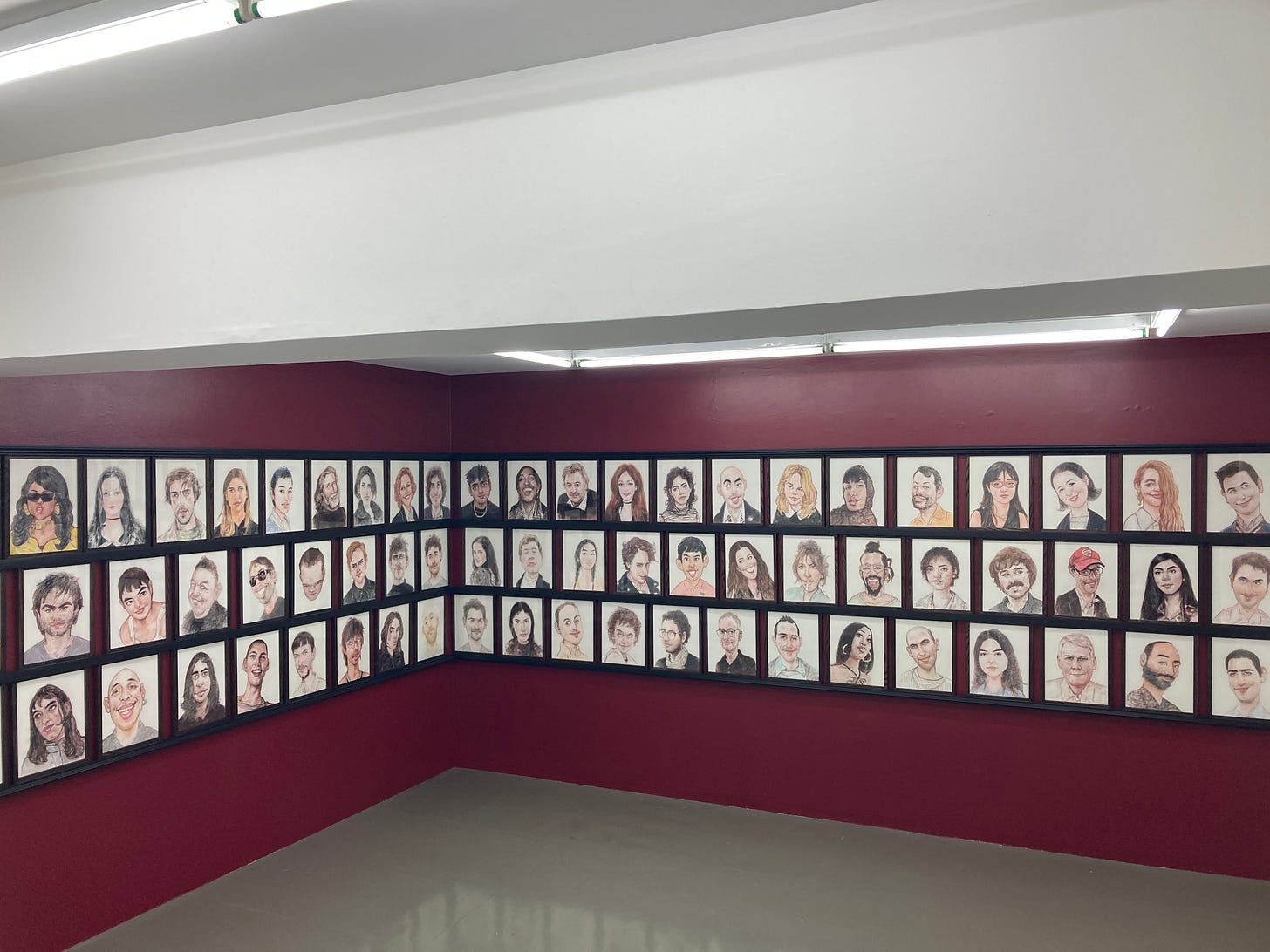Note: This week Spigot offers its first bonus issue for paid subscribers ONLY. Featuring scabrous photographic content, a history of art about the art world, and the mounting angst of millennials as they approach their cultural twilight.
Art
My feelings about the Amalia Ulman show are complicated. Actually, my feelings are simple: I kind of hated it. My thinking about it is a good deal more complex, however.
The exhibition, titled Jenny’s at JENNY’S, is a dense hang of nearly one hundred small framed cartoons of denizens of what people like Graydon Carter refer to as the downtown scene crammed onto two of the room’s four walls. They depict the people you are likely run into at a Jenny’s opening, or the Odeon, or more dumbassed places I’ve no need to name. Ulman’s caricatures are meant to mimic those hanging at the old Times Square haunt Sardi’s, where patrons famous in Broadway circles are immortalized.
I think no one would be offended by my calling Ulman’s drawings ugly. Their ghastliness contributes to the phenomenological traction the exhibition successfully generates—claustrophobia in one half of the space, room to breathe in the other. Jenny’s at JENNY’S stages a social experience by having so many faces looking back at you. All those eyes make you a bit self-conscious. It’s nauseating, given how hideous they all look.
The display speaks to the concerns with power dynamics that Ulman has shown in her work, which has been too little seen in New York. It also resonates with the probing of our obsession with notoriety threaded throughout her 2021 film El Planeta, which richly depicts the relationship between a woman and her mother as they deal with the emotional and financial impact of her father’s death—including their impending eviction.
In person, alone in the gallery, it feels like Jenny’s at JENNY’S must be a critique, a self-reflexive indictment of how droolingly desperate people in the art world are for attention and how often that pairs with their snobby superiority, a world where quite a few people ignore you or condescend to you if they don’t think you’re important enough. The waters are particularly sharky for people up to and through Ulman’s age, the early thirties.
The problem, however, is that the simulated social experience you get at the show is secondary to the actual sociality in which the show is embedded. If the show satirizes a certain segment of the New York art world, holding a mirror up to its cliquey nature, it also functions within it. And the effects there will inevitably be much more potent and long lasting than any IRL one. Asking someone to appear in your show, informing them that you’re doing it, doing it as a surprise to them all curries favor. It’s flattery, even if the actual images are less than flattering. A gentle mockery is part of the point: they’re caricatures, after all, like those disfiguring the greasepaint grandees on the walls at Sardi’s. A ribbing by one’s fellows indicates a certain status within a group, the vibe more wedding toast than Twitter roast.
And so the show exists in social relations more than in its physical location, more on Instagram than on Pell Street. The physical appurtenances become a mere stage set for an opening or a pass-by, a selfie station for photo after photo of people with pic-snapping phone in one hand, (metaphoric) dick in other as they pose grinning with their likenesses and (figuratively) jack themselves silly. Whether you think these people seem vain and how you gauge the intention of the artist vis-à-vis them determines more than any of its more tangible qualities whether you think Jenny’s at JENNY’S is a good work of art.
But the show exists here, too, in Spigot, in the frustration and disappointment bleeding through my prose. That degree of efficacy once again advocates in the work’s favor. Yet there’s something annoying about being annoyed. My irritation with the project is clearly part of the project. When in 2007 the well-paid Merlin Carpenter brought his own brand of mise en abyme criticality to Reena Spaulings, scrawled DIE COLLECTOR SCUM on a canvas in Chinatown, and bolted out of his vernissage into the night, my eye rolling was part of the show. In that sense, the presentation of such work—like Carpenter’s The Opening, like Ulman’s Jenny’s—sets up a power struggle with the viewer akin to trolling. If you’re provoked by the provocation, you lose. Your disdain, be it kneejerk or reasoned, is subsumed into the work itself to serve the artist’s aspirations.
In the end, my thinking about the show comes down to a familiar question: Is Ulman’s show a critique of something we don’t like or is it simply that unlikeable thing itself? Yes, we’re back to the tedious question of irony and post-irony, which itself is rooted—like the art world—in in-group and out-group distinctions. The ultimate answer to the question is both and neither; the degree of critical distance you perceive within the work will depend upon where you stand. Consider irony not as a formal quality but as a speech act, an expression meant to impose a double meaning on someone else unawares. Jenny’s at JENNY’S clearly seems ironic to some degree. But against whom is that irony being wielded, its subjects or its audience? In what quantity does the latter ultimately exceed the former?
The bottom-line and most honest critical question: Would I like the show if I were in it? Maybe, though I’d like to think otherwise.
Despite being about shallowness, Ulman’s show isn’t itself shallow. I’m not saying it’s bad. But I can say for sure that the regularly modish genre of art about art-world micropolitics mostly feels too tricky, self-involved, and low stakes for me to get interested, and I don’t want to see it come return for a while. Seeing Jenny’s at JENNY’S is like seeing the approach of an unwelcome visitor to whom you just said goodbye. Back so soon?
Books
Money by Émile Zola
Set in the 1860s, the book follows the rise and fall of Aristide Saccard, an all-purpose schemer who always has a river of gold coursing through his hands but never can seem to keep hold of it, to use one of Zola’s own recurring metaphors. Having lost the fortune he gained in a previous novel, The Kill, he plots to amass a new, even greater horde of wealth on the French stock exchange via a holding company with banking and industrial concerns that he’s founded with a couple of religious types. They aim to return the Levant to Christendom—yikes—while he aims merely to make as many francs as possible. Puffing up the stock to absurd heights through bookkeeping tricks and other plus-ça-change shenanigans, he turns the Bourse into a battlefield, complete with a climactic scene on the trading floor that, if Zola changed stocks and margin calls to guns and cavalry charges, could be a scene in his book on the Franco-Prussian War, La Débâcle.
In its discussion of finance, Money is almost impossibly clear and precise. A journalist by training, Zola details this often opaque world in a way that’s not just vivid; it’s riveting. The book’s subplots are just as high-stakes and whirlwind as Saccard’s machinations, manipulations, and setbacks, including various backstabbings, seedy romances, and an attempt to blackmail him over the fact that he has a secret son. Zola’s eye for Parisian spectacle—he’d have called it decadence—is as sharp as it is for finance. And props to Valerie Minogue for her translation: to this lay reader, it’s exceptional.
Saccard is a terrible person; among other things, he’s virulently antisemetic (despite Zola’s own Dryfusardian bent), and that secret son turns out to be the result of his committing rape. But as great novelists so often do with morally dubious protagonists, Zola suckers us in by making him prone to occasional fits of unexpected generosity, even decency. He’s most distinguished by his lack of material lust, vis-à-vis the petty characters who surround him anyway. Of course he likes the fine clothes, carriages, jewels, horses, kept women. But what he cares most about is money, in an almost abstract way that makes him seem above the fray. He claims an elevated perspective, just like the reader, and that Provençal charm that works so well on those around him—until it doesn’t—does a number on us as well.
Wine
The second-cheapest red wine on the menu at the Odeon
If someone else isn’t picking up the check and you’re a lower-tier culture-industry toiler, Spigot advises that, for the preservation of your threadbare psyche, never order the lowest-priced wine on the menu at a restaurant. Cheapest: so gauche. Second cheapest: brilliant! Next to last may mark our lives’ ceilings but hardly our ability to appreciate the finer things in life. The server will never dream that you’re a poor person masquerading as lower middle class.
If you’re in this demographic, the Odeon sees you. New York’s most enduring venue for schmoozing and bathroom selfies knowingly offers five reds at its second-lowest price point, a nevertheless-sigh-inducing $64. Is tonight the night you step out and try that mysterious cousin of Châteauneuf-du-Pape, the Vacqueyras? Do you cross the Pyrenees into Iberia to try the Garnacha or Rioja? Or are you swayed by the label biodynamic to choose the Barbera, dubiously nicknamed “Tom”?
On Saturday night, after a life-transforming reading at Artist’s Space, we played it safe and ordered the remaining option, a Bordeaux. It was perfectly fine—balanced and nondescript, streambed crunchy and tight with not a lot of flavors to distract you from your sparkling conversation and enough oak to numb your mouth a little, though not quite as much as the post-nasal drip from your cheap cocaine. But no complaints. Odeon once again proves that they care about even their lowliest customers by offering them a totally palatable Médoc that goes just fine with your $22 omelette. After you finish the first glass, are you really going to taste it anyway?






